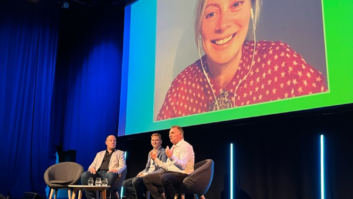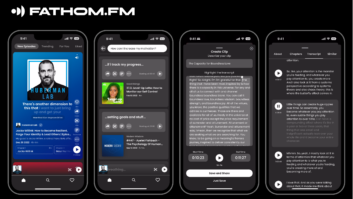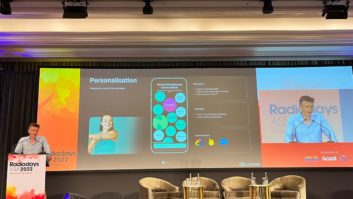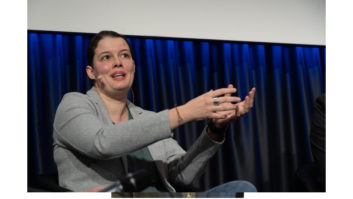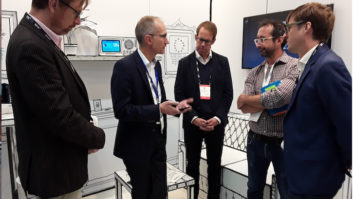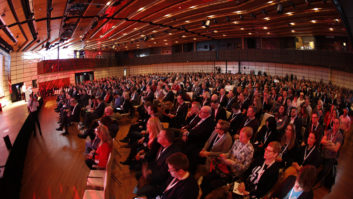The author is manager of strategic technology applications for NPR Labs.
For more than 40 years, radio reading service stations have served blind, low-vision and print-impaired listeners by making the printed word accessible to millions who otherwise would be excluded from literature and news sources the sighted population takes for granted.
RRS staff, mostly volunteers, read newspapers, books, magazines, catalogues and other materials — from the timely to the arcane — over an FM station’s Subsidiary Communications Authorization channel to their intended audience. In the coming years, RRS stations are expected to migrate from SCA to HD Radio channels, and will be able to take advantage of improved audio fidelity and the rich data paths HD Radio technology offers.

NPR Labs’ Rich Rarey holds the first PAIS-enabled HD Radio receiver. Created at NPR Labs and based on iBiquity’s 1281/1282 reference receiver, the unit has 96 hours of internal recording time and HD Radio Conditional Access. The microcontroller code for PAIS functionality uses only 10 kB of memory. The PAIS receiver is housed in a custom enclosure with a sloping front to indicate its use as an accessible device. Photo by Leslie Stimson To that end, NPR Labs, in partnership with the International Association of Audio Information Services, sought and received a federal grant from the National Institute on Disability and Rehabilitation Research to create a practical way to identify RRS programs by category, transmit that information as Program Service Data in an HD Radio channel, and develop a working HD Radio receiver that enables blind and low-vision listeners to select desired programs for capture and later listening — including traditional rewind/fast forward/scan transport functionality.
The project is called the Personalized Audio Information Service. PAIS has provisions for emergency alerting as well; at the reception of an alert category the HD Radio receiver automatically begins recording the message.
Prototype
In the course of the three-year PAIS project, NPR Labs worked with IAAIS to create a basic set of 109 RRS program categories and developed a working prototype of a PAIS-enabled HD Radio receiver to test and refine the receiver’s user interface with blind and low-vision test subjects.
NPR Labs also devised software processes to transmit and receive PAIS category information as HD Radio program service data and created a working PAIS-enabled HD Radio receiver.
This work is straightforward and easy to understand; NPR Labs published details about the project in a white paper, “The Technical Basis of PAIS,” available at www.nprlabs.org. The paper describes the PAIS data flow, the PAIS categories — which are field-upgradable — and other programmatic and technical concepts.
An RRS station will have two different methods for generating PAIS tags for broadcast.
For live programs, the human reader can press an external keypad button that triggers a software application to generate and send the PAIS tag to the station’s HD Radio importer. For automation system playback, an NPR Labs software application acts as the interface to retrieve the PAIS information from the automation system, and send the PAIS tag to the importer.
We demonstrated the keypad method at the 2010 NAB Radio Show; the custom software we developed interfaced to an external X-Keys 20 button keypad, and sent PAIS tags to the importer of Washington station WETA(FM) over the public Internet. The PAIS-enabled HD Radio receiver detected and validated the PAIS tag, and started recording the program.
For audio playback, NPR Labs is working with an automation system’s developers to interface their system with the NPR Labs custom software. Other automation system vendors may already have an iBiquity Digital development license and, with slight modifications to their existing code, send PAIS tags directly to the RRS station’s importer.
Why it matters
Other than immediately assisting sight-impaired Americans who seek information and entertainment from RRS stations by putting it literally at the touch of a button, the PAIS project benefits all listeners, sighted and sight-impaired listeners alike. How does PAIS benefit everyone?
First, because we’re all getting older.
The number of Americans with print impairments will double over the next three decades, according to the American Council of the Blind. Approximately 19 million Americans, 9 percent of the population, over the age of 18 currently experience vision trouble, defined as trouble seeing, even with glasses or contacts. As age increases, the percentage of adults with vision troubles increases.
As the ACB states on its website, “The number of print-impaired Americans is expected to grow dramatically as ‘baby boomers’ reach retirement age, and it is projected that the number of Americans with print impairments will double over the next three decades.” Radio reading services will be an increasingly important connection to printed media for an increasing number of Americans.
Second, the techniques to create, change, delete and transmit PAIS categories are applicable to “mainstream” radio programming as well.
(click thumbnail)
The PAIS XML tags are intended to be sent within the COMMent field of an HD Radio channel. The field is implemented in iBiquity’s importer/exporter code and does not require additional coding to transmit. HD Radio receivers can handle the COMMent field, although it is not usually displayed. A PAIS PAD application — created at NPR Labs — accepts triggers from an automation system and an external keypad. Once triggered, the application forms a PAIS XML tag based on the triggered information and sends the PAIS XML tag to the station’s HD Radio importer/exporter. Source: “The Technical Basis of PAIS,” NPR Labs Imagine for a moment that commercially syndicated talk shows, personality programs, as well as the whole of public radio programming were categorized with PAIS “tags” when broadcast, allowing anyone with a PAIS-enabled radio to select for recording anything from “Sean Hannity” to “All Things Considered” to “Glenn Beck” to “Fresh Air” for later listening — an entirely plausible combination.
The recorded programs stay within the HD Radio receiver, and cannot be exported out of the receiver. This emphasizes the personal nature of PAIS.
PAIS is one of several projects at NPR Labs that target opportunities to make radio accessible. We’re working on another NIDRR grant-funded initiative to bring radio to the deaf-blind community by translating broadcast radio programs into text (as captioning), then translate that text into a serial stream suitable for sending to the listener’s Braille display.
Once the difficulty of creating an accurate, real-time radio captioning stream is completed, it’s an easier matter to translate that stream to different display devices, thus serving the deaf community and the deaf-blind community at once.
How many Americans could we expect to help with this initiative?
While the Helen Keller National Center for deaf-blind estimates the number of deaf-blind Americans to be between 70,000 and several hundred thousand people, demographic analyses by Mississippi State University’s statistician William Sansing in 2006 projected an additional 1 to 1.24 million older adults with dual sensory loss by 2010.
Gallaudet University’s Research Institute analyzed data drawn from a U.S. Census Bureau survey and concluded that in 2002 there were 8 million Americans who were hard of hearing and 1 million Americans who were “functionally deaf.” Here, then, are Americans who cannot use radio at all, just because we broadcasters have not made our product accessible.
Yet we receive enthusiastic encouragement from our blind, deaf and deaf-blind colleagues, who very much want to experience radio, and enjoy radio’s ability to entertain, inform and notify. They want to enjoy these attributes in real time and also saved for later.
These citizens have guided our efforts and are eager to help us bring radio to them. Imagine: a new radio audience created — not with expensive marketing or ad campaigns — but just by merely making the radio medium accessible.
Rich Rarey is also a contributor to Radio World; here, he writes in his role with NPR Labs.
Radio World welcomes other points of view.






